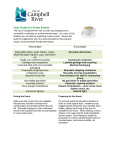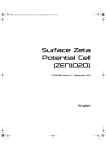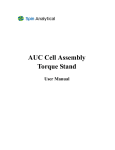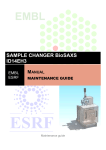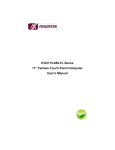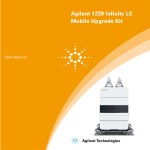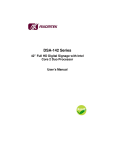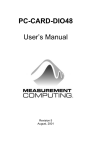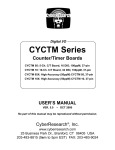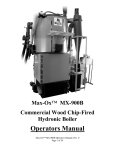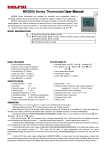Download AUC Cell Washer User Manual
Transcript
AUC Cell Washer User Manual AUC Cell Washer User Manual WARRANTY Spin Analytical Inc., warrants this product to be defect free in both material and workmanship for 90 days from the date of shipment. Labor services are guaranteed for 12 months. During the warranty period, we will, at our discretion, either repair or replace any product or product component that proves to be defective. For warranty support and information please visit our website at www.spinanalytical.com or contact a customer service representative at [email protected] LIMITATION OF WARRANTY This warranty does not apply to defects resulting from product modification without Spins written consent, misuse of any product or part, or failure to follow instructions. DO NOT open instrument case. Opening case by unauthorized personnel will void warranty. SAFETY PRECAUTIONS This product is intended for use by qualified personnel who recognize hazards and are familiar with the safety precautions required to avoid possible injury. Read and follow all installation, operation and maintenance information carefully before using this product. Refer to the manual for complete product specifications. If the product is used in a manner not specified, the protection provided by the product may be impaired. Only use approved Spin Analytical accessories with the Single-Cell Cell Washer. Improper use of Cell Washer can result in damage to your AUC cell components. NEVER operate the machine with the cover open. NEVER defeat the safety sensors (cover interlock and cell sensors). ALWAYS follow local regulations when disposing of drain waste. *Because of geometry constraints, the cell washer is only for use with 2-channel velocity centerpieces, it cannot be used with 2-hole flow through centerpieces or 6-channel equilibrium centerpieces. AUC Cell Washer User Manual Table of Contents Introduction..................................................................................................1 Cell Washer Included Equipment................................................................2 Quick Set Up Instructions............................................................................3 Product Description.....................................................................................3 Cleaning the Cell.........................................................................................9 Recommended Protocol.............................................................................10 Multi-cell AUC Cell Washer.........................................................................11 Appendix 1: Solvents Table.........................................................................12 AUC Cell Washer User Manual AUC Cell Washer 1 Introduction The AUC Cell Washer is a simple, stand alone, fault tolerant device for washing AUC cells without time consuming disassembly and reassembly. The whetted materials are Viton, PTFE, Polypropylene, and Stainless Steel and so a variety of different cleaning solutions can be used (Appendix 1). The Cell Washer allows washing and rinsing with up to four solutions, followed by a drying step. The time for each step may be set independently. Once the desired times are selected, just press the START button to begin washing the cell. If desired, the Cell Washer will sound an alarm when the cycle is complete (see the Product Description and Recommended Protocol sections for step-by-step instructions). All controls are identical for Single-cell and Multi-cell AUC Cell Washers. For additional Mutli-cell information see section 7, Multi-Cell AUC Cell Washer. Advantages of the Cell Washer include: Faster than manual cleaning Reproducible cell washing, rinsing and drying protocol Cells remain assembled, and are less likely to have leaking problems Able to leave sample in one channel and only change sample in the other channel *This manual is for both the Single and Mutli-cell AUC Cell Washer Page 1 AUC Cell Washer User Manual 2 Cell Washer Included Equipment Included Cell Washer Components (see Figure 1) (1) Cell Washer. (4) 500 ml glass bottles. (4) Bottle tops with air inlet filter and output check valve and barbed fitting installed with Viton tubing with valved quick disconnect fitting. (1) Drain hose (18” long 1/4” ID Viton tube). (1) Drying hose: 1/4” clear PVC tube with quick disconnect fittings on one end. (1) PEEK cell housing adapter(s). (1) Electronically controlled air pump with PVC tubing. (1) 12V power supply with 120V power cord. Figure 1: Included Cell Washer Components Page 2 AUC Cell Washer User Manual 3 Quick Set Up Instructions The Spin Analytical Cell Washer requires very little set up: Remove the Cell Washer from box and remove tape holding cover down. IMPORTANT: Place Cell Washer on level surface (Drain is gravity fed). Remove tubing with quick connect fittings and 500 ml glass bottles from box. Remove dust covers from the 500 ml glass bottles and fill bottles with appropriate fluids (see Recommended Protocol). Install 2-port bottle tops with tubing onto the 500 ml glass bottles. Plug the quick disconnect fitting at the end of the tube from each bottle cap into the appropriately labeled fitting on the left side of the Cell Washer case. Push the 18” black Viton hose onto the barbed drain fitting on the right side of the case (Because it is gravity fed, the drain hose should NEVER be placed higher than the barbed drain fitting. Be sure to dispose of waste in the appropriate waste disposal container and manner). Unpack the 12V power supply and plug into a power outlet, connect the round power plug into the jack on the back of the Cell Washer case. Plug the clear 1/4” PVC tube with quick connect fitting into the fitting on the left side of the cell washer labeled “Dry”. On arrival, the system may contain distilled water which should be purged before first use. CAUTION: If you are not using the electronically controlled air pump, your air or dry nitrogen source must be regulated and cannot exceed 10 psi or damage will result to the solenoids inside the Cell Washer. 4 Product Description NOTE: Because of geometry constraints, the Cell Washer is only for use with 2-channel velocity centerpieces, it cannot be used with 2-hole flow through centerpieces or 6-channel equilibrium centerpieces. Cell Washer Front Control Panel Rotary selector knobs for selecting wash and dry times. Green LEDs indicate selected bottle. Red LED, power indicator. Black push button to start Red push button to stop Page 3 AUC Cell Washer User Manual Figure 2: Cell Washer Front Panel Cell Washer Inlet Side (4) valved quick connect fittings for fluid input. (1) non-valved quick connect fitting for drying. (1) BNC fitting for air pump control. Figure 3: Cell Washer Inlet Side Panel Page 4 AUC Cell Washer User Manual Wash Bottles Each Cell Washer comes with four 500 ml glass bottles with GL45 tops. The blank tops on the bottles are for shipping purposes only. To assemble the Cell Washer, replace the blank tops with the two-port tops with tubing attached. One of the ports of the two-port bottle top is an air vent and has a small filter to prevent dust entering the bottle. The tube from the second port delivers fluid to the Cell Washer. The fluid tube has an inline check valve to prevent fluid from draining back into the bottle when not being used, and a quick disconnect fitting on the end of the tube for connecting to the Cell Washer. Air Line Connect the 1/4” clear PVC tube with quick disconnect fitting which is attached to the electronically controlled air pump, to the quick connect fitting labeled “Dry” on the left side panel of the Cell Washer. CAUTION: If you decide to use some other source for drying (compressed dry nitrogen or house air), it is important to be sure to regulate the pressure not to exceed 10 psi. Higher pressure will likely damage the Cell Washer. Air Pump If you are installing the Spin Analytical electronically-controlled air pump, simply attach the cable with the BNC connector onto the BNC fitting on the left side labeled “Air Pump”. Figure 4: Spin Analytical Electronically-Controlled Air Pump Cell Washer Drain Side 1/4” barbed Polypropylene fitting for Viton drain hose Page 5 AUC Cell Washer User Manual Figure 5: Cell Washer Drain Side Panel Drain Hose An 18” long, 1/4” ID, black Viton tube is to be used to drain the used washer fluid. Place Cell Washer on a level surface near appropriate waste disposal/recovery container. Connect drain hose to the barbed fitting on the right side of the Cell Washer. NOTE: Fluid draining is gravity based; the black Viton tubing and waste disposal container must be at a level lower than that of the Cell Washer barbed fitting. Cell Washer Back Panel 12VDC power jack. Black ON/OFF switch. Power fuse Alarm ON/OFF switch. Figure 6: Cell Washer Back Panel Page 6 AUC Cell Washer User Manual Power Unpack the 12V power supply and connect the 120V power cord. Plug the round 12V plug from the power supply into the back of the Cell Washer and the 120V power cord into the wall. Cell Washer Top Figure 7: Top of Cell Washer Cover The top of the Cell Washer unit has a hinged cover with clear sides. The cover is an integral part of the safety system of the Cell Washer. The unit can not function if the cover is not closed. An interrupting style optical sensor located at the back left side of the cover is used to determine if the cover is closed. Saddle Block Under the cover is the “Saddle Block” which holds the cell during cleaning (figure 7). The block has a cylindrical cutout for the cell to rest in with a hole in the middle for draining the fluid. The needle which delivers the washing solutions to the cell protrudes through the drain hole. An optical sensor mounted to an aluminum post is used to determine whether a cell is loaded. If a cell is not loaded the unit will not allow the user to start the wash cycle. Cell Adapters A flat bottom PEEK adapter is supplied to help seal the cell housing from washing fluids. Although it is not necessary to use the adapter, it is possible that some fluid may leak onto the saddle if it is not used. The adapter screws into the fill hole of the channel to be washed (after removing the fill hole screw and gasket). We recommend leaving the fill hole screw and gasket in place in the channel not being Page 7 AUC Cell Washer User Manual washed. This helps to ensure no cross contamination during cleaning. The washing needle is then threaded up through the adapter and into the fill hole of the centerpiece. Figure 8 shows the adapter installed in a cell housing. The adapter should only be finger tight. NEVER USE A TOOL to tighten the adapter. Over tightening the adapter could result in damage to the centerpiece or cell housing. Figure 8: Cell Adapter Installation Operation Summary Connect solvent bottles, air source and drain. Check levels of fluids in bottles (if empty refill and prime with dummy cell). Switch on power to Cell Washer (and air pump). Install cell adapter in side to be washed. Install cell (hole to be washed closest to back of machine). Select wash and dry times. Press START button. Remove cell, and dry exterior surface of fill hole and saddle. Repeat with second channel. Power Plug the 12VDC power supply which came with the Cell Washer into a wall outlet and the jack on the back of the unit. Turn on the power to the Cell Washer with the black rocker switch located on the back of the unit. A red LED located on the front panel indicates the power is on. If using the optional electronically controlled air pump, turn on power to it too. Page 8 AUC Cell Washer User Manual 5 Cleaning the Cell To install the cell: Remove fill hole screw and gasket from channel to be cleaned. Leave fill hole screw installed in side not being washed. Recover sample if desired. Install cell adapter in cell fill hole of side to be washed. Lift cover. Place cell onto needle (IMPORTANT: for proper installation the fill hole to be washed should face toward the back of the Cell Washer, toward the cell sensor post. In order to wash the second channel the cell must be rotated end for end. The reason this is necessary is that the fill hole angle is not along the radius of the cell but at a slight angle). Close the cover (activates the cover sensor switch). Select the desired wash and dry times from the rotary selector knobs on the front control panel. Make sure the drain tube is directed into an appropriate waste disposal container. Press the START (black button) on the front control panel. Wash Cycle Information Alarm At the end of the wash cycle, an alarm will sound for 2-3 seconds to alert the operator. The alarm can be disabled by the red push button on the back of the case. Wash and Dry Times The selector knobs on the front panel allow the user to determine the length of time of each individual step of the wash/dry cycle. The wash times can be set to 0, 0.5, 1 and 2 minutes and the dry time can be set to 0, 2, 5, and 10 minutes. For maximum flexibility, each step has a 0 setting. When the step is set to ‘0’ minutes, the step will simply be skipped. Canceling The user can stop the wash cycle at any time by pressing the red STOP button. Also, it is possible to skip a step by changing the selector knob to the 0 position even after a cycle has been started. When started, the Cell Washer follows the sequence shown in the table below. STEP 1 Bottle 1 STEP 2 Air Bottle 2 STEP 3 Air Bottle 3 STEP 4 Air Bottle 4 Air STEP 5 STEP 6 Dry Purge STEP 1: Pumps liquid from Bottle 1 for selected time and delivered to the cell through the needle inserted in the cell channel. After the wash part of the step is complete, air blown through the needle for approximately 10 seconds. This blows the fluid out of the cell and allows for increased agitation at the beginning of the next step. Page 9 AUC Cell Washer User Manual STEP 2: same as STEP 1, but with Bottle 2 STEP 3: same as STEP 1, but with Bottle 3 STEP 4: same as STEP 1, but with Bottle 4. Also, at the end of the washing phase of this step, air is forced out of the system directly to the drain in order to clear the internal tubing of fluid. STEP 5: Activates air pump and blows air through the needle to the cell for selected time. STEP 6: Pumps water from Bottle 1 through the system directly to drain for approximately 60 seconds. The purpose of this step is to clear the system of any solvent from the previous washing step. This ensures that the next time the washer is used, the first fluid introduced to the cell is water. No water is delivered to the cell during the purge step so the cell remains dry. NOTE: Because Bottle 1 is used to purge the system in STEP 6, it should always be filled with distilled water. 6 Recommended Protocol While it is possible to use a wide range of solvents in the Cell Washer, for most applications the following sequence is recommended. The times assume the system has previously been primed: 1. Distilled water (1 minute). This flushes out the cell contents and reduces the chances for reactions with the cleaning solution. 2. Hellmanex II, 1% solution (1 minute). This cleans the cell without leaving a residue. 3. Distilled water (2 minutes). Rinses cell. 4. 80% Ethanol, Methanol or Isopropanol (1 minute). This is a drying agent and can be skipped if you complete the drying manually or by vacuum. We recommend against using 95% ethanol, which can leave a residue. CAUTION: DO NOT use denatured alcohol, it will cause damage to the internal tubing. 5. Dry (2-5 minutes), depending on how dry the lab air is. If you use low pressure (<10 psi) dry nitrogen will dry the cell in 2 minutes. If you do not use ethanol (or other alcohol) in step 4, the cell will not be dry (but most of the water will be flushed from the cell). The drying can be completed manually using dry nitrogen or house vacuum and a desiccator. CAUTION: Mixing alcohol with some solutions (ex. RBS) will result in a milky film left on the window. Page 10 AUC Cell Washer User Manual 7 Multi-Cell AUC Cell Washer The Multi-cell AUC Cell Washer has the same controls as the Single-cell AUC Cell Washer. However, with the Multi-cell, you are able to wash up to four AUC cells at once. This does not mean you need to wash four cells every time you use the Cell Washer. The Cell Washer can detect which saddle block(s) is occupied and will only deliver fluid to that saddle block if a cell is present and the cover is closed. Page 11 AUC Cell Washer User Manual Appendix 1: Solvents Table Care has been taken to ensure that all of the whetted materials contained in the Cell Washer are chemically resistant. Although, we recommend using the Spin Analytical “Cell Wash” fluid, it is possible to use a variety of solvents with the Cell Washer. The whetted materials are EPDM (tubing, solenoid valves, pump valves), PTFE (tubing, solenoid bodies, PEEK and Polypropylene (tube fittings), Stainless Steel. EPDM is the material which limits the chemical compatibility. Contact Spin Analytical if a solvent you want to use is not on the approved solvents list below. Approved Solvents Acetic Acid Acetone Alcohols (Isopropyl, Ethyl, Methyl) Ammonia Clorox (Bleach) Detergents (RBS, Hellmanex II) Hydrochloric acid (<20%) Hydrogen peroxide (<10%) Calcium Hydroxide Potassium Hyrdoxide Sodium Hydroxide (1 M) Nitric acid (<20%) Sulfuric acid (<10%) EtOH Water DMSO EDTA- WARNING: This will corrode the aluminum cell housings Page 12















